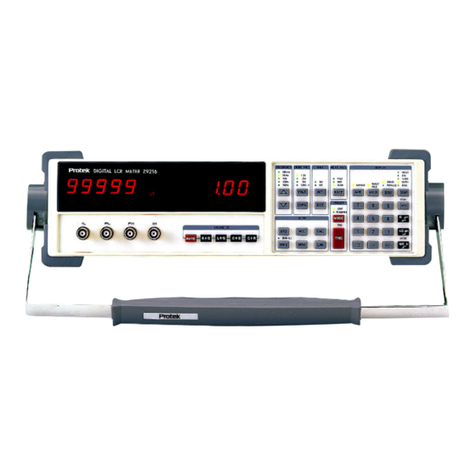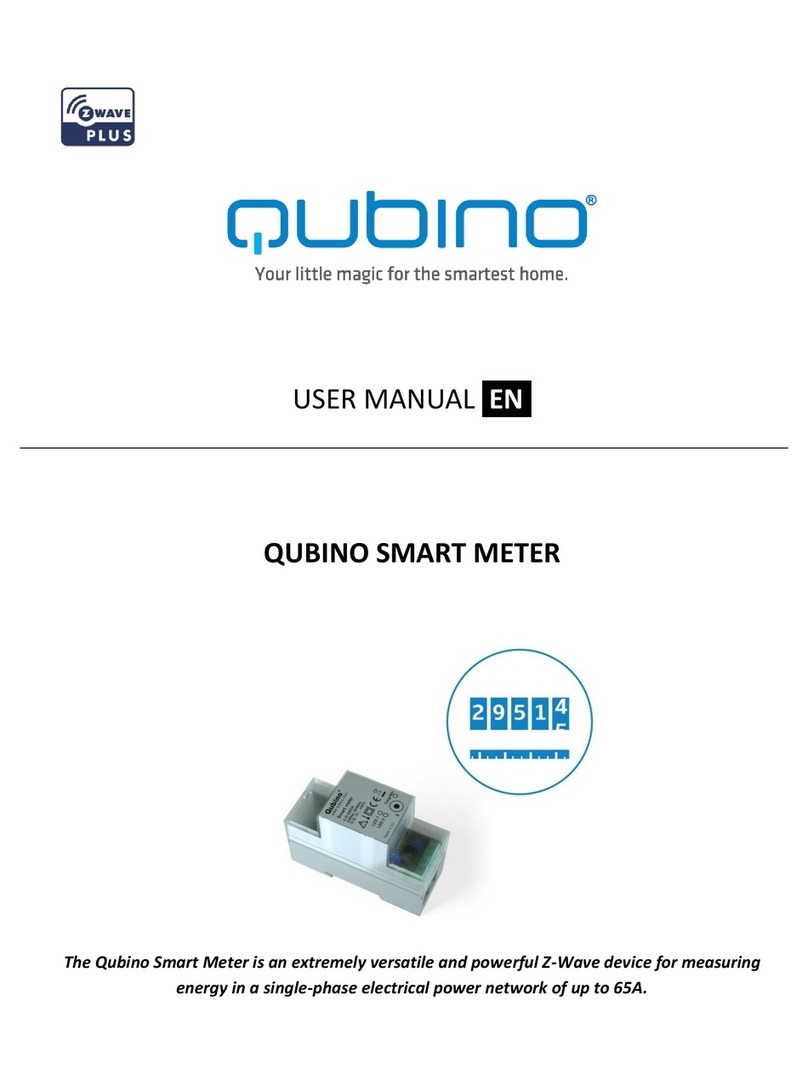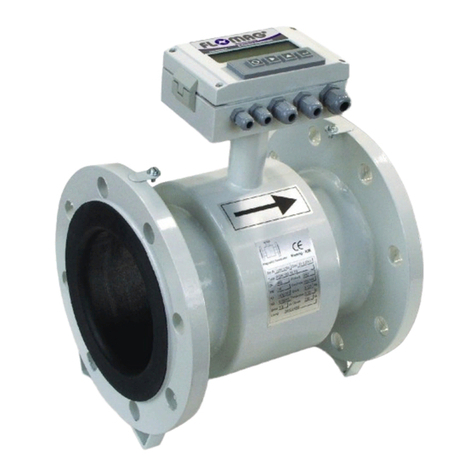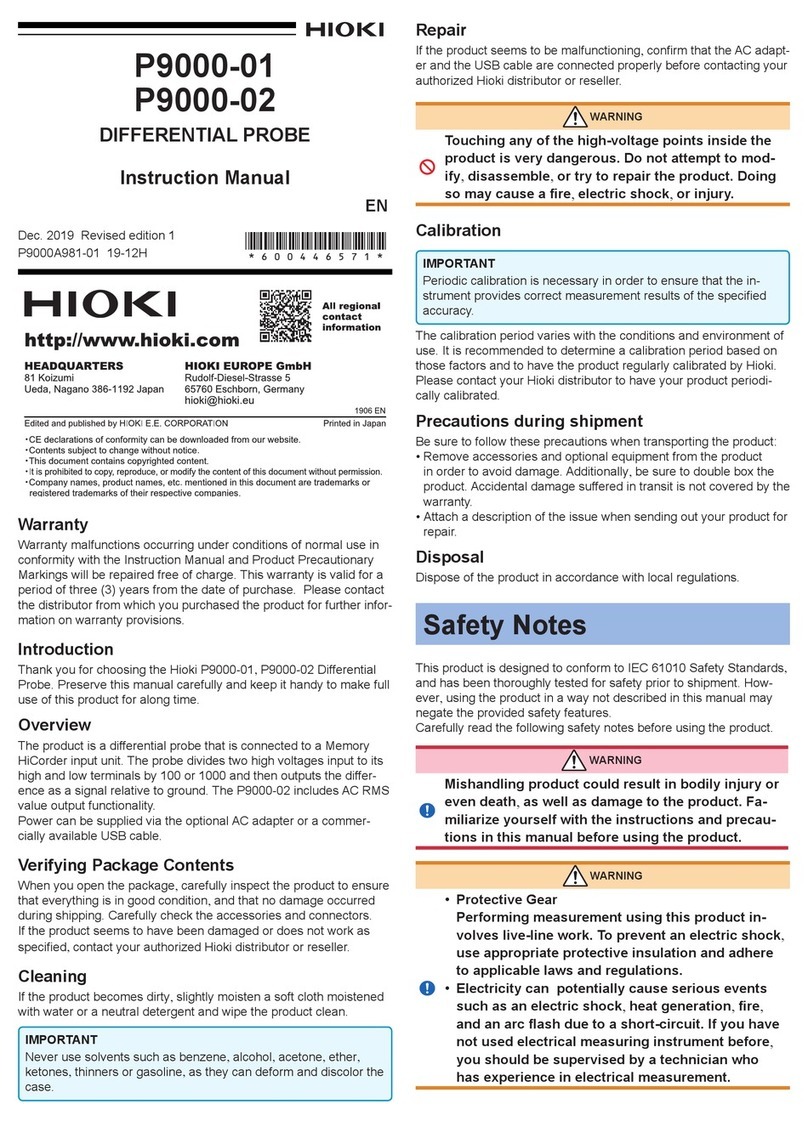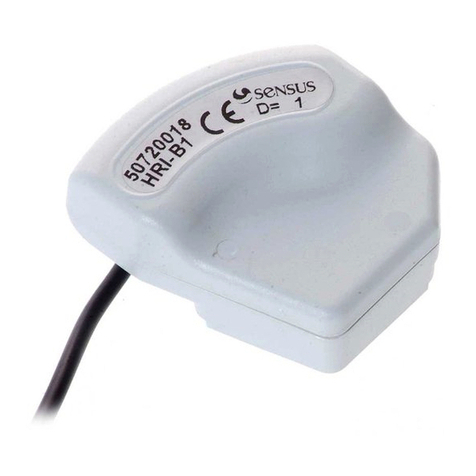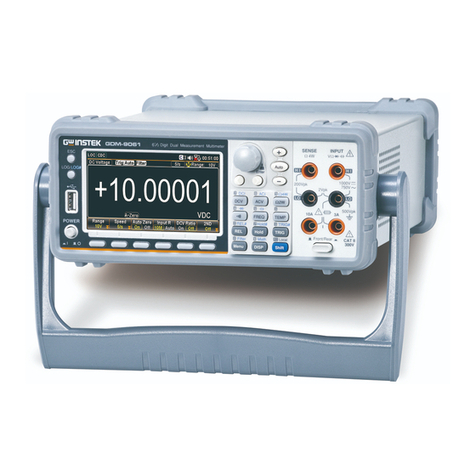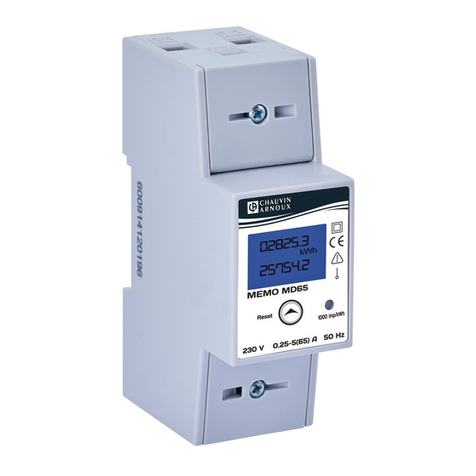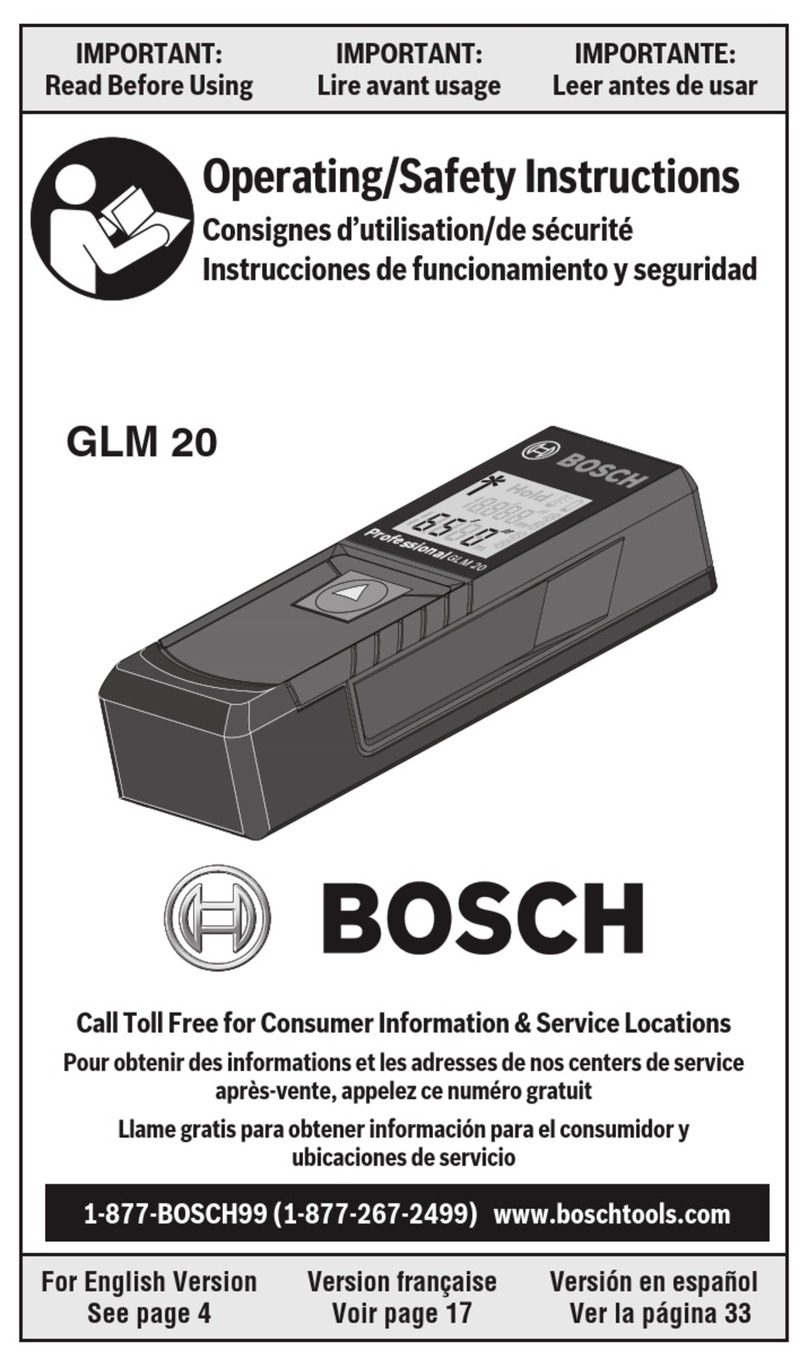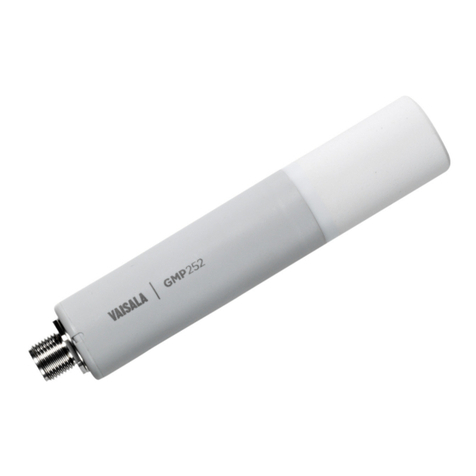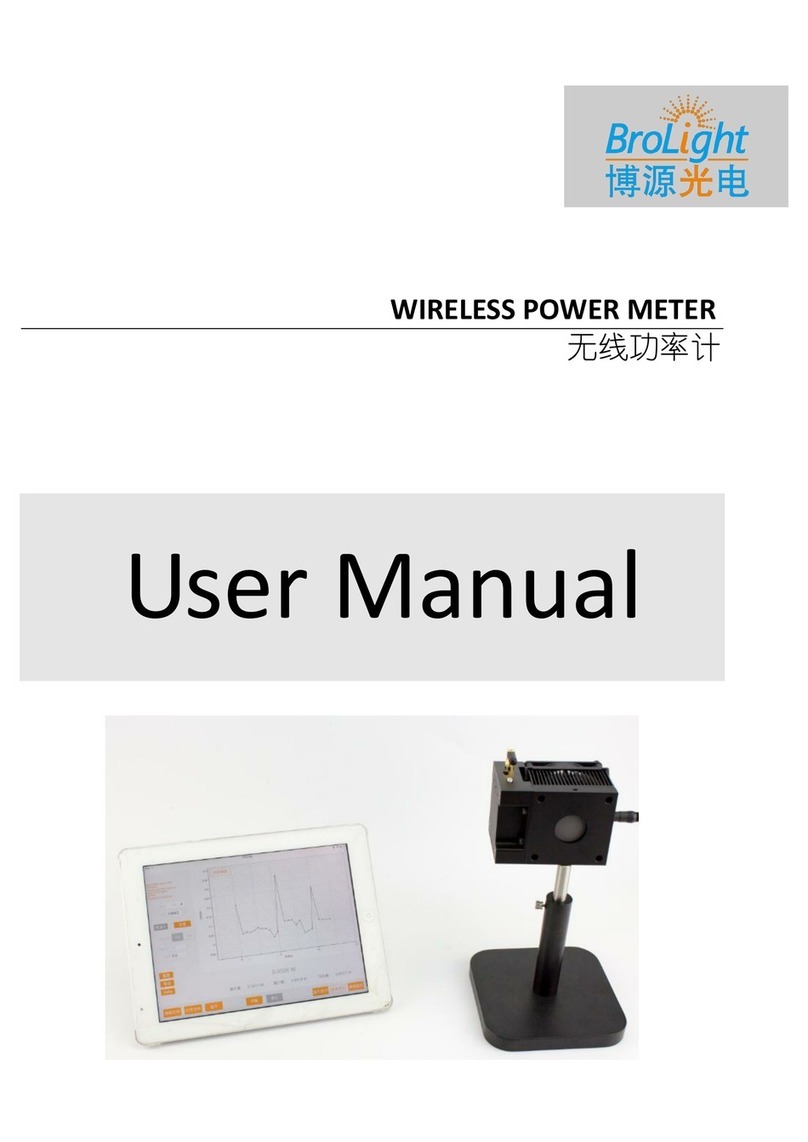PRO-TEK A434L User manual


2
INTRODUCTION................................................................................ 6
FIRMWARE VERSIONS....................................................................... 6
SAFETY INSTRUCTIONS ..................................................................... 7
CERTIFICATE .................................................................................. 11
1 GENERAL OVERVIEW............................................................... 12
1.1 Description....................................................................... 13
1.2 Specifications ................................................................... 13
1.2.1 Basic Specifications .................................................... 13
1.2.2 Key Measurements..................................................... 15
1.2.3 Key Features.............................................................. 15
1.3 The Layout of A434L......................................................... 16
1.4 Ordering Information ........................................................ 17
1.4.1 Standard Accessories.................................................. 17
1.4.2 Options..................................................................... 19
2 PREPARATION FOR USE ........................................................... 21
2.1 General Information.......................................................... 21
2.2 Power Adaptor................................................................. 21
2.3 Battery............................................................................. 22
2.3.1 Caution..................................................................... 23
2.3.2 Installing a Battery...................................................... 24
2.3.3 Charging a Battery ..................................................... 25
2.3.4 Battery Low............................................................... 25
2.3.5 Battery Power Off ...................................................... 26

3
2.4 Front Panel....................................................................... 27
2.4.1 Key Layout ................................................................ 27
2.4.2 ① Function Hard........................................................ 28
2.4.3 ② Soft Keys ............................................................... 28
2.4.4 ③ Power Switch Key .................................................. 28
2.4.5 ④ Multi Keys ............................................................. 29
2.4.6 ⑤ ESC, Back, Arrow Keys............................................ 33
2.4.7 ⑥ Enter Keys ............................................................. 34
2.4.8 ⑦ Knob Keys ............................................................. 35
2.4.9 Display...................................................................... 35
2.5 Upper Panel ..................................................................... 36
2.5.1 DC Power Connector.................................................. 37
2.5.2 RF OUT/Reflection...................................................... 37
2.5.3 Ethernet Port............................................................. 37
2.5.4 USB Port ................................................................... 38
2.6 FAN................................................................................. 38
2.6.1 FAN Operation .......................................................... 38
2.6.2 FAN alarm ................................................................. 38
3 GETTING STARTED .................................................................. 40
3.1 Power Up......................................................................... 41
3.1.1 Initialization............................................................... 41
3.1.2 System Information.................................................... 42
3.2 Layout of the Display Screen .............................................. 43
3.3 Function Hard Keys Structure ............................................. 45
3.3.1 System Screen Menu.................................................. 46
3.3.2 Common Menu ......................................................... 47
3.3.3 VSWR Menu.............................................................. 52
3.3.4 DTF Menu ................................................................. 54
3.3.5 Cable Loss Menu........................................................ 55
3.3.6 Power Meter Menu.................................................... 57
3.4 System Key....................................................................... 58

4
3.5 Multi Keys ........................................................................ 60
3.5.1 Numeric Data Entry.................................................... 61
3.5.2 Specific Function Keys ................................................ 61
4 MEASUREMENT DATA ANALYSIS.............................................. 70
4.1 VSWR .............................................................................. 71
4.1.1 VSWR Display Description........................................... 71
4.1.2 Setting Frequency ...................................................... 74
4.1.3 Calibration ................................................................ 75
4.1.4 VSWR Measurement .................................................. 77
4.1.4.1 Setting Trace Point .............................................. 79
4.1.4.2 Scale Adjustment................................................ 79
4.1.4.3 Using Markers .................................................... 79
4.1.4.4 Limit Line ........................................................... 80
4.2 DTF ................................................................................. 81
4.2.1 DTF Display Description .............................................. 81
4.2.2 DTF Setup ................................................................. 83
4.2.3 Calibration ................................................................ 85
4.2.4 DTF Measurement...................................................... 87
4.2.4.1 Scale Adjustment................................................ 88
4.2.4.2 Using Markers .................................................... 89
4.2.4.3 Windowing ........................................................ 89
4.3 Cable Loss........................................................................ 91
4.3.1 Cable Loss Display Description..................................... 91
4.3.2 Setting Frequency ...................................................... 92
4.3.3 Calibration ................................................................ 93
4.3.4 Cable Loss Measurement ............................................ 95
4.3.4.1 Scale Adjustment................................................ 96
4.3.4.2 Using Markers .................................................... 96
4.4 Power Meter .................................................................... 97
4.4.1 Connecting Sensors.................................................... 97
4.4.2 Setting Power Meter .................................................. 99
4.4.3 Power Measurement................................................ 100

5
4.5 Save & Load ................................................................... 101
4.5.1 Save ....................................................................... 101
4.5.1.1 Save Trace........................................................ 102
4.5.1.2 Save Screen ...................................................... 103
4.5.1.3 Save State ........................................................ 104
4.5.2 Load ....................................................................... 105
4.5.2.1 Load Trace ....................................................... 105
4.5.2.2 Load Screen...................................................... 107
4.5.2.3 Load State........................................................ 107
4.5.2.4 Memory Type ................................................... 107
5 SOFTWARE UPGRADE............................................................ 108
5.1 Upgrade Method ............................................................ 109
6 WARRANTY INFORMATION.................................................... 113
Appendix 1 —Band List................................................................. 117
Appendix 2 —Cable List ................................................................ 125

6
This Operating Manual represents design, specifications, overview of
functions, and detailed operation procedure of A434L RF master, to ensure
effective and safe use of the technical capabilities of the instrument by the
user.
RF Master operation and maintenance should be performed by qualified
engineers with initial experience in operating of microwave circuits and PC.
The following abbreviations are used in this Manual:
PC –Personal Computer
DUT –Device Under Test
IF –Intermediate Frequency
CW –Continuous Wave
SWR –Standing Wave Ratio
The first edition of this Operating Manual applies directly to instruments that
have the firmware version 1.xx.

N
7
Carefully read through the following safety instructions before putting the
Analyzer into operation. Observe all the precautions and warnings provided
in this Manual for all the phases of operation, service, and repair of the
Analyzer.
The Analyzer must be used only by skilled and specialized staff or thoroughly
trained personnel with the required skills and knowledge of safety
precautions.
A434L complies with INSTALLATION CATEGORY II as well as POLLUTION
DEGREE 2 in IEC61010–1.
A434L is MEASUREMENT CATEGORY I (CAT I). Do not use for CAT II, III, or
IV.
A434L is for INDOOR USE only.
A434L is tested in stand-alone condition or in combination with the
accessories supplied by GS INSTRUMENTS CO., LTD. against the
requirement of the standards described in the Declaration of Conformity. If
it is used as a system component, compliance of related regulations and
safety requirements are to be confirmed by the builder of the system.
Never operate the Analyzer in the environment containing inflammable
gasses or fumes.
Operators must not remove the cover or part of the housing. The Analyzer
must not be repaired by the operator. Component replacement or internal
adjustment must be performed by qualified maintenance personnel only.
Never operate the Analyzer if the power cable is damaged.
Never connect the test terminals to mains.

8
Electrostatic discharge can damage your Analyzer when connected or
disconnected from the DUT. Static charge can build up on your body and
damage the sensitive circuits of internal components of both the Analyzer
and the DUT. To avoid damage from electric discharge, observe the
following:
-Always use a desktop anti-static mat under the DUT.
-Always wear a grounding wrist strap connected to the desktop
anti-static mat via daisy-chained 1 MΩ resistor.
-Connect clamp on the body of the Analyzer to the body of
the DUT before you start operation.
Observe all the general safety precautions related to operation of equipment
powered by mains.
The protection provided by the equipment may be impaired if the
equipment is used in a manner not specified by the manufacturer.The
definitions of safety symbols used on the instrument or in the Manual are
listed below.
Storage
Before first use store your equipment in the factory package at
environment temperature from 0 to +50 ºС and relative humidity up to
95% (at 25ºС).
After you have removed the factory package store the equipment at
environment temperature from +10 to +35 ºС and relative humidity up
to 80% (at 25ºС).
Ensure to keep the storage facilities free from dust, fumes of acids and
alkalies, aggressive gases, and other chemicals, which can cause corrosion.

N
9
Moderate Ventilation
Maintain moderate ventilation condition to prevent overheating of the
product.
Environment
Ambient temperature 2ºС to 50ºС
Maximum 80% RH between 2ºС and 31ºС,
decreasing to 50% RH at 50ºС
Maximum altitude 2,000m
MAINS supply voltage fluctuations up to 10% of the
nominal voltage
Transient over-voltages according to installation
category II
Pollution degree 2
IPX0
Warning
Never perform cleaning of the instrument if the power cable is connected
to the power outlet.Never clean the internal components of the instrument.
Do not position the equipment so that it is difficult to operate the power
cord.
Refers to the Manual if the instrument is
marked with this symbol.
Alternating current.
Direct current.
On (Supply).
Off (Supply).

10
A chassis terminal; a connection to the
instrument’s chassis, which includes all exposed
metal structure.
CAUTION
This sign denotes a hazard. It calls attention to a
procedure, practice, or condition that, if not
correctly performed or adhered to, could result
in injury or death to personnel.
CAUTION
This sign denotes a hazard. It calls attention to a
procedure, practice, or condition that, if not
correctly performed or adhered to, could result
in damage to or destruction of part or the entire
instrument.
Note
This sign denotes important information. It calls
attention to a procedure, practice, or condition
that is essential for the user to understand.

11
CERTIFICATE

OPERATING
MANUAL
GENERAL
OVERVIEW
1

13
1.
1.1 Description
A large number of cell site problems are caused by the antenna system,
cable, or connectors. It is important to have the right instrument available
when either servicing or certifying cell sites for operation.
The Protek A434L RF master is a lightweight portable diagnostic tool for an
accurate detection of operational problems. The Protek A434L has all the
measurement functions necessary to accurately verify the antenna system
from VSWR to power measurements. In addition, the Protek A434L makes
distance-to-fault measurements to accurately pinpoint the fault's location.
The Protek A434L user interface is with a front keypad and a TFT color, 7-
inch display providing ease of use and control. The application specific
software allows the user to easily compare and analyze measurements and
generate comprehensive reports. The Protek A434L is equipped with a
rechargeable and infield installable lithium-ion battery providing over four
hours of operation.
1.2 Specifications
1.2.1 Basic Specifications
Item
Sub Item
Specification
General
Max Input Power
+25dBm Damage level
Frequency Range
5MHz to 4GHz
Frequency Accuracy
< ±3ppm
Frequency Resolution
10kHz
Impedance
50Ω
Scan Speed
< 1msec /data point
Display
Single & Dual mode
Test port
N Female

14
Test curve storage
Internal : Minimum 512MB
External : Limited by size of USB
(32G)
Screen storage
Setup storage
VSWR
Number of data points
126, 251, 501, 1001, 2001
Return loss Range
0 to -60dB
VSWR Range
1 to 65
Cable Loss
Cable loss range
0 to -30dB, 0.01dB Resolution
Interference
Immunity
On-Frequency
+10dBm
On-Channel
+20dBm
DTF
Return Loss Display
Range
0 to 60dB
Distance Range
0 to 1250m (4125ft)
VSWR Display Range
0 to 65
Miscellaneous
Dimension
260X193X67mm
Weight
<2.45Kg include battery
A434L Voltage and
Current
12Vd.c., 3.5A
Adaptor
AC Input
100 to 250Vd.c., 1.5A
DC
Output
12Vd.c., 5A
Battery
Li-lon (4hr operating time after
full charging), 12Vd.c.,
7600mAh
Environmental
Operating Temperature
0°C ~ +50°C
Storage Temperature
-40°C ~ +80°C (-40°F ~ +176°F)
Humidity
95%R.H. NO Condensation
Degree of protection
IPX0
Power
Meter(Option)
Frequency Range
20MHz to 3.8GHz
Sensor Type
Average
Peak Power Sensor
-40dBm to +10dBm
Accuracy
±7%
Test Port
Precision N Female
Table 1.1 Basic Specifications

15
1.2.2 Key Measurements
High resolution VSWR Measurements
Distance to Fault (DTF) Measurements
Cable Loss Measurements
RMS Power Measurements (optional)
1.2.3 Key Features
Rechargeable and infield replaceable lithium-ion battery
Built-in world-wide signal standards and frequency
channels
7 Inch TFT color display viewable in daylight
Dual display to view multiple measurements
simultaneously to reduce test time
Easy front keypad operation
Superior immunity to RF interference
Up to 2001 data points to locate long range problems
Built-in cable menus containing >90 cables’
characteristics
User friendly menu structure
Saves up to Memory (user setups, traces, screens)
Alphanumeric labeling of saved data
Automatic Time/Date stamp of saved data
USB Port (USB 2.0)
Remote firmware upgrade capability

16
Fast one-touch selection of menu item or positioning
marker
Smart Battery management can be check Battery
capability
Rechargeable and field replaceable Lithium Ion battery
with more than 4 hours operation time
Backlight keypad for easier use in dark environments
Sun-Light Readable LCD for readability
1.3 The Layout of A434L
Figure 1.1 A434L Front Panel

17
Figure 1.2 A434L Rear Panel
Figure 1.3 A434L Upper Panel
1.4 Ordering Information
1.4.1 Standard Accessories
The standard accessories supplied with the A434L RF Master are as
follows:

18
Description
Picture
Specification
Soft Carrying Case
AC-DC Adapter
Input: 100 ~ 240Va.c.,
1.5A
Output: 12Vd.c., 5A
Neck Strap
Hand Strap
Li-ion Battery
Output: 8.4Vd.c. MAX,
7800mAh
User’s Manual
Hard Copy

19
1.4.2 Options
The options supplied with the A434L RF Master are as follows:
Description
Picture
Specification
Power Sensor
(Part No: S134)
Frequency Range
: 20MHz to 3.8GHz
Sensor Type : Average
Peak Power Sensor
: -40dBm to +10dBm
Accuracy : ±7%
Test Port : Precision N
Female
Battery Charger
(Part No: C122R5)
Input: 100 ~ 240Va.c.,
1.5A
Output: 12Vd.c., 5A

OPERATING
MANUAL
PREPARATION FOR
USE
2
Table of contents
Other PRO-TEK Measuring Instrument manuals
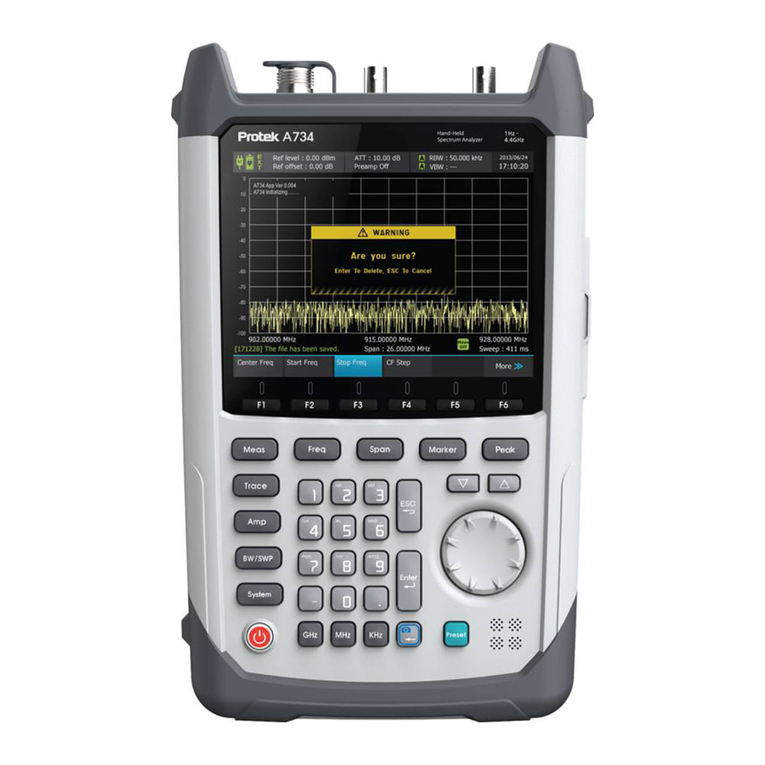
PRO-TEK
PRO-TEK A734 User manual
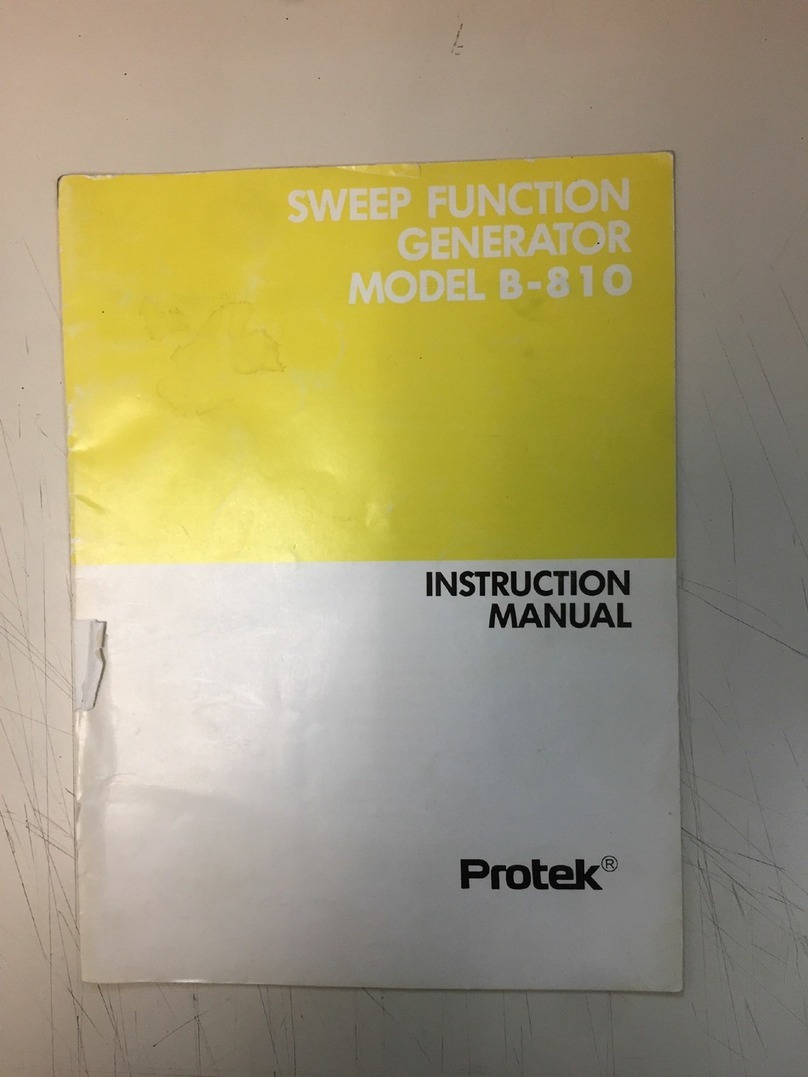
PRO-TEK
PRO-TEK B-810 User manual
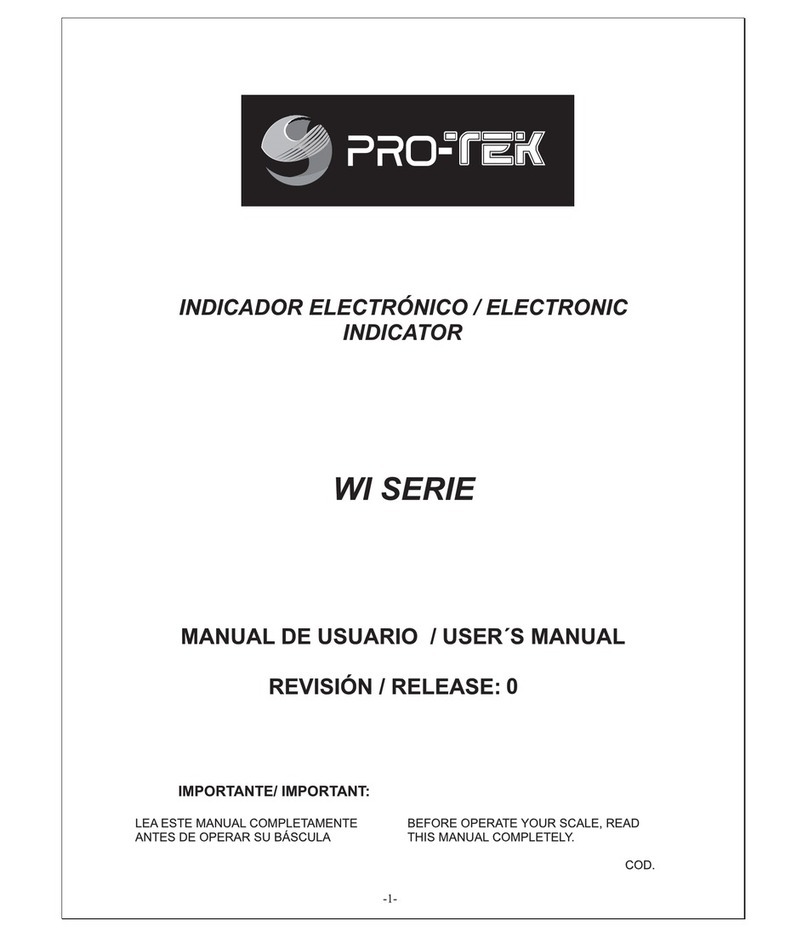
PRO-TEK
PRO-TEK WI Series User manual
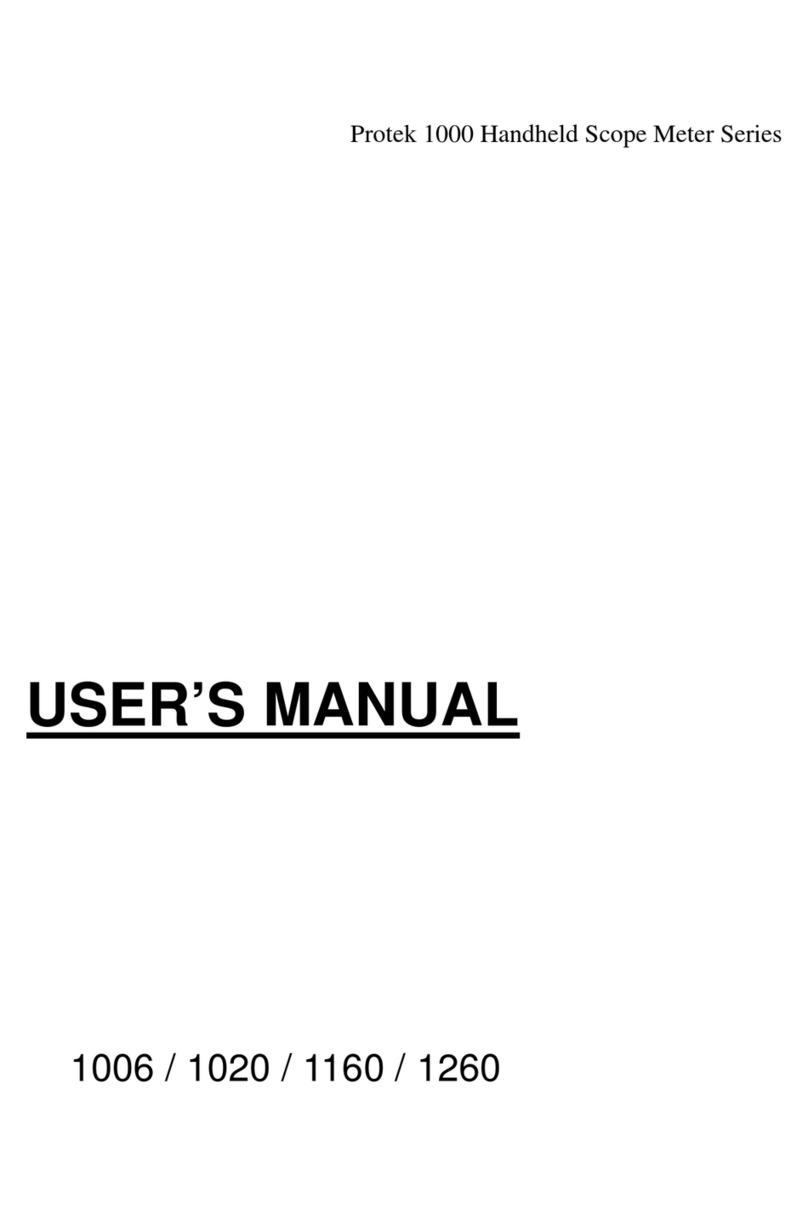
PRO-TEK
PRO-TEK 1006 User manual

PRO-TEK
PRO-TEK A734 User manual

PRO-TEK
PRO-TEK 3201 User manual
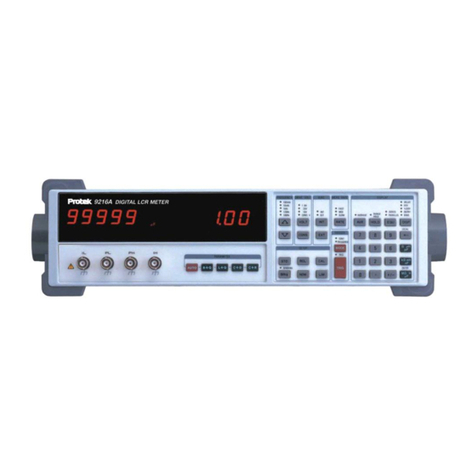
PRO-TEK
PRO-TEK 9216A User manual
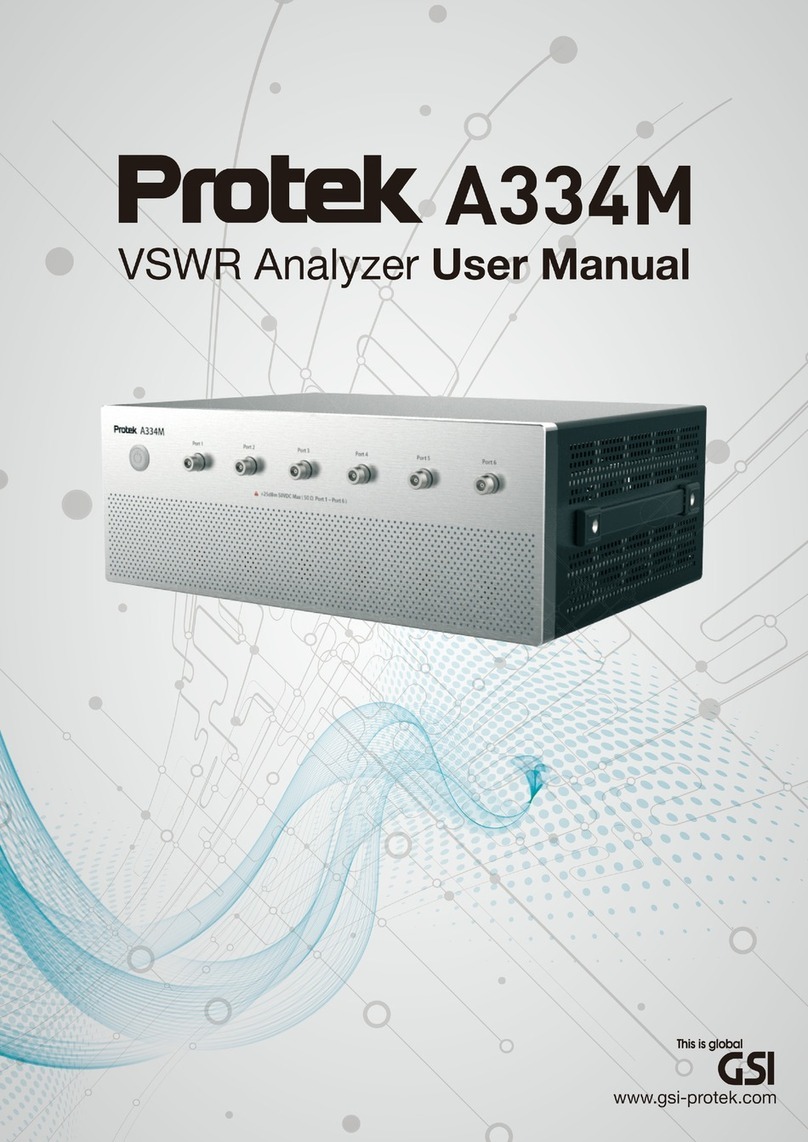
PRO-TEK
PRO-TEK A334M User manual
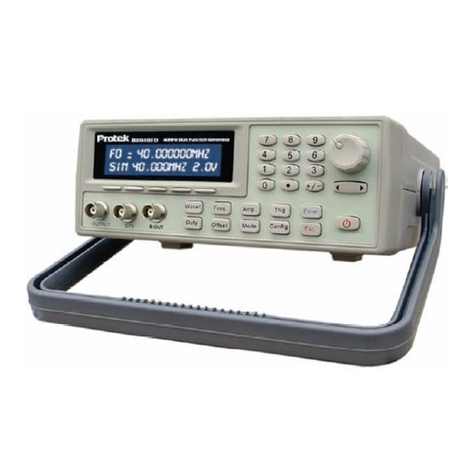
PRO-TEK
PRO-TEK B8000FD Series User manual
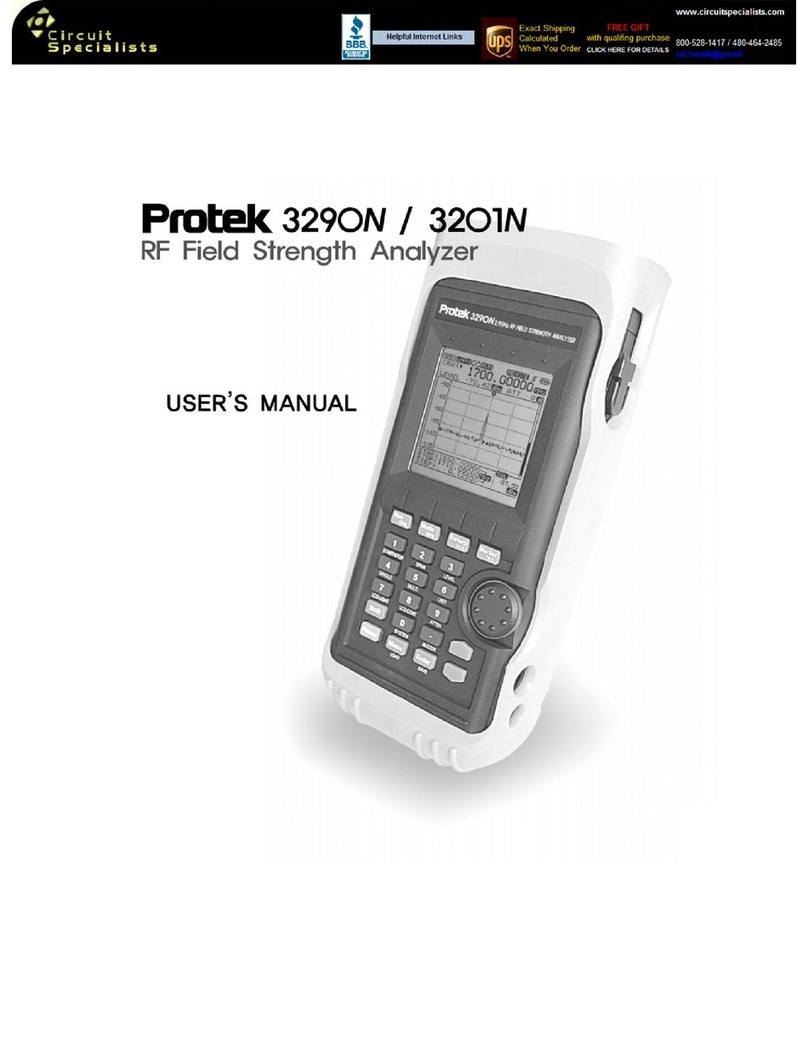
PRO-TEK
PRO-TEK 3290N User manual
Popular Measuring Instrument manuals by other brands
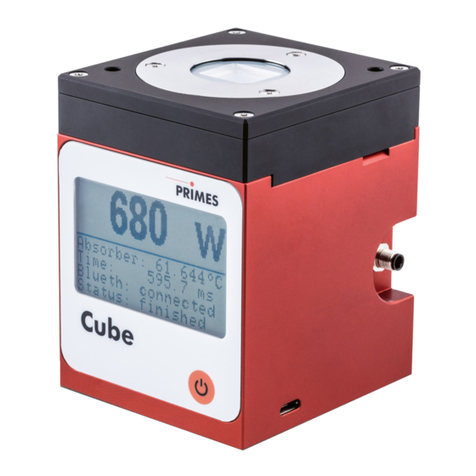
Primes
Primes Cube M operating manual
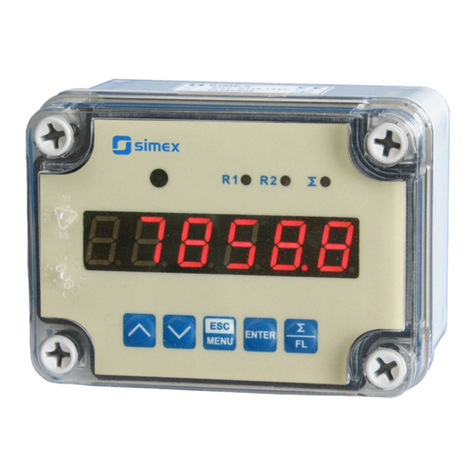
Simex
Simex SPP-N118 user manual
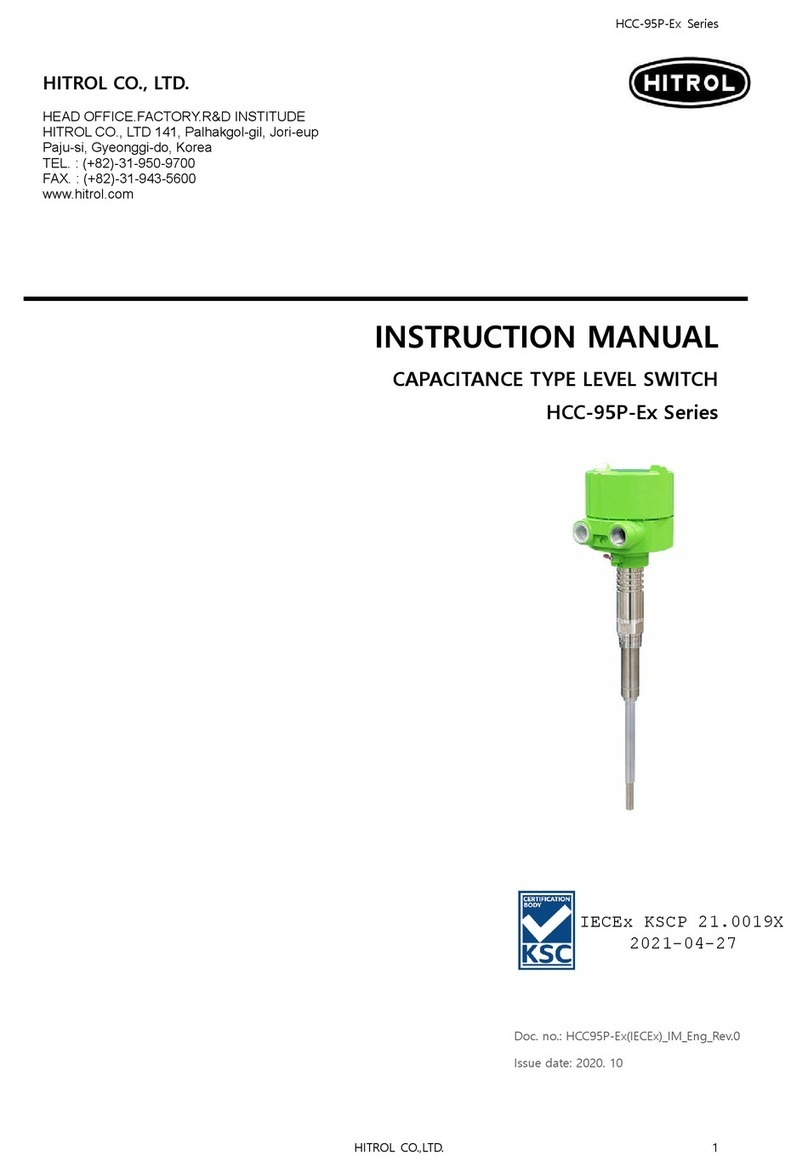
HITROL
HITROL HCC-95P-Ex Series instruction manual
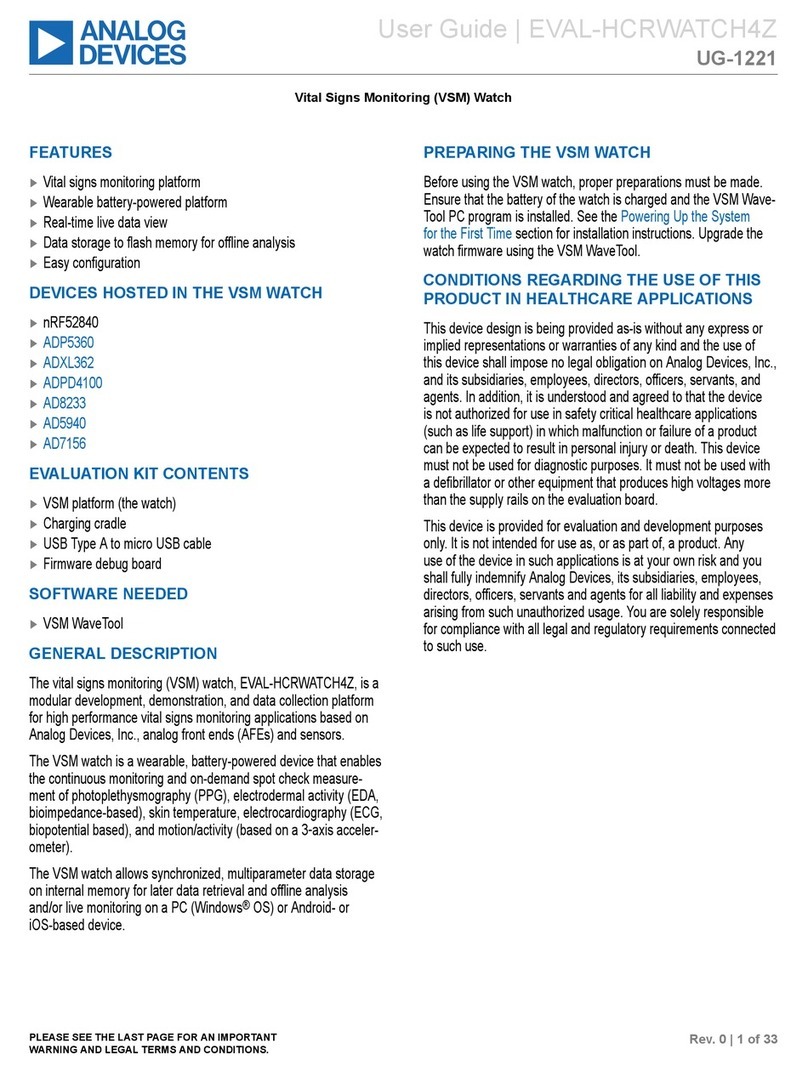
Analog Devices
Analog Devices UG-1221 user guide
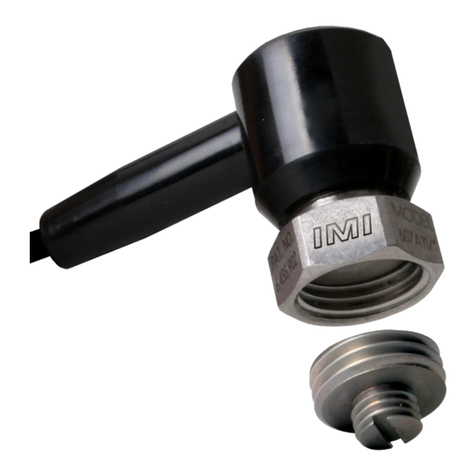
PCB Piezotronics
PCB Piezotronics IMI SENSORS TO607A11 Installation and operating manual
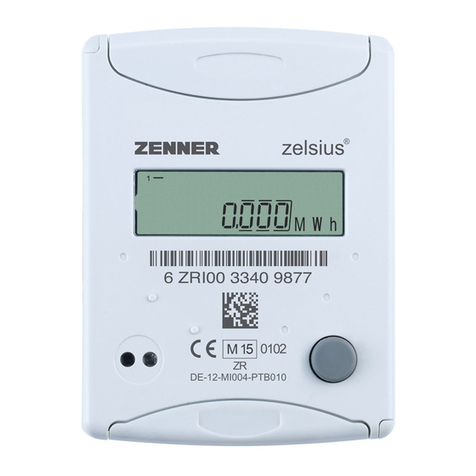
Zenner
Zenner zelsius C5-ISF Installation and operating manual
